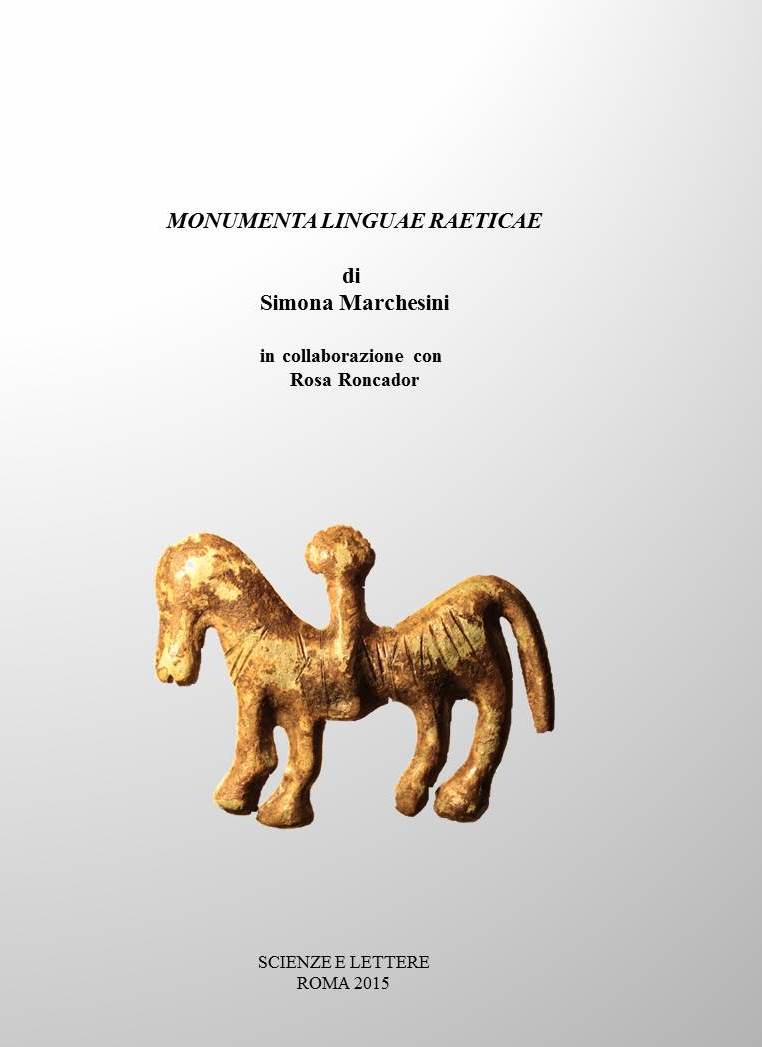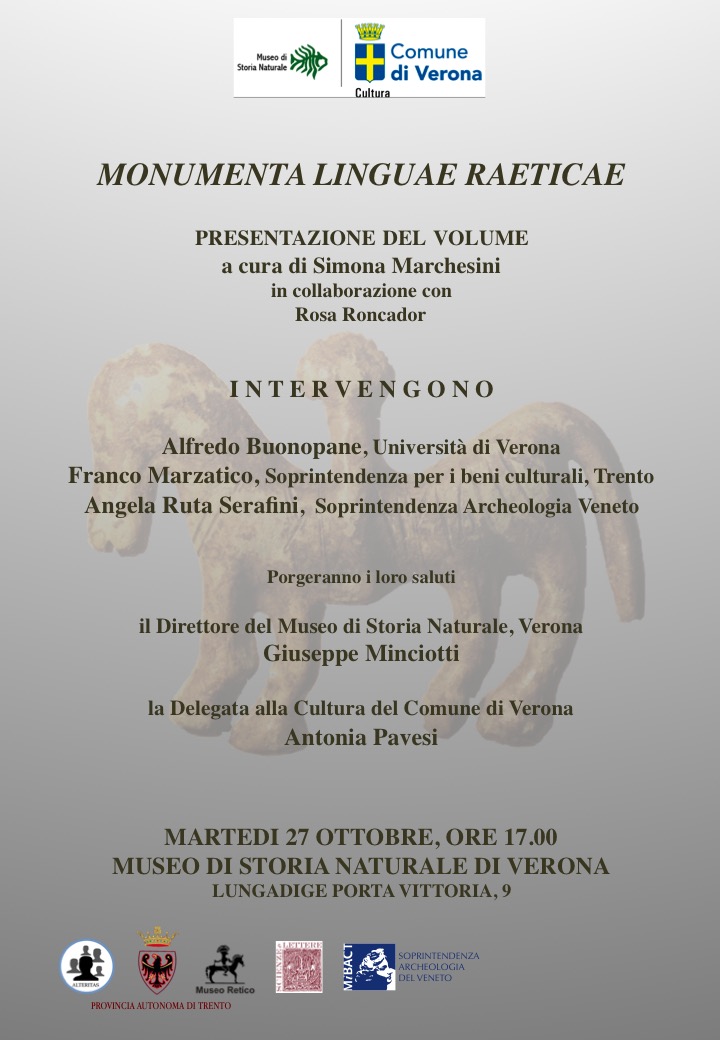On 27 October 2015, the presentation of the volume Monumenta Linguae Raeticae, published by Scienze e Lettere, Rome, edited by S. Marchesini in collaboration with Rosa Roncador, was held at the Museum of Natural History in Verona. The volume was presented by Alfredo Buonopame, Angela Ruta and Franco Marzatico.
The volume Monumenta Linguae Raeticae stems from a multidisciplinary research project (2013-2014) supported by Banco Popolare di Verona and Alteritas – Interazione tra i popoli. The project, aimed at investigating relations between peoples in the area formerly inhabited by the Raeti, saw as its first step the reconnaissance and subsequent publication of the epigraphic repertoire of the Rhaetian area. The corpus of Rhaetian inscriptions is the result of close collaboration between specialists, in particular between linguists and archaeologists, a necessary and indispensable prerequisite in the study of fragmentary languages such as Rhaetian, which are characterised by a lacunose and uncertain linguistic reconstruction. The editorial project, coordinated by Simona Marchesini, was conducted in collaboration with the Trentino archaeologist Rosa Roncador, to whom we owe the introductory sheets on the sites, the revision of the archaeological data – both with regard to the typology and chronology of the epigraphic supports – and the support in some of the autopsies carried out. Vittorio Dell’Aquila, a linguist with extensive computer skills, assisted with the IT part of the project and the editing of the text; he is also responsible for the topographical map of the sites that accompanies the volume. Mara Migliavacca, an archaeologist specialising in the Veneto region, edited the topographical maps of the Veneto region. The publication of the volume was sponsored by the Archaeological Heritage Office of the Autonomous Province of Trento.
The distribution area of Rhaetian epigraphy mainly comprises three regions: Trentino-Alto Adige, the Austrian Tyrol and Veneto. Finally, a few inscriptions come from the Lower Engadine (Switzerland). If the majority of the testimonia come from the area of Sanzeno in Val di Non (TN), the propelling centre of Rhaetic culture in the first part of the attestations (from the end of the 6th to the end of the 5th century BC), a consistent nucleus of documents comes from the district of Magrè (with Magrè, Rotzo and Piovene, near Vicenza) and from the Veronese, with the localities of Montorio, San Giorgio di Valpolicella, San Briccio di Lavagno and Ca’ dei Cavri.
By proposing a typological analysis of the alphabetical types of all the inscriptions and a chronological framework based on innovative investigative tools (such as the epigraphic seriation analysis presented in the “wake graphs” at the end of the volume), the volume is presented as a tool intended for different categories of users:
– firstly, the inhabitants of the three regions affected by the discovery of Rhaetian epigraphs, who find in this work the written traces of those who preceded them in time;
– scholars of ancient history and epigraphy, both pre-Roman and Roman, for whom the epigraphic data is a privileged cornerstone in the reconstruction of the history of the Rhaetian district.
– the linguists, who find in the isolation of some new words – thanks also to an index of isolated words, and the reverse index – new material for the study of this fragmentary language, which they now know is genealogically related to Etruscan;
– archaeologists, who find not only epigraphic evidence of the relationships between the different Rhaetic districts, but also a chronological proposal for most of the 300 edited texts.
Such a work is also able to provide important historical results, such as the position of the Veronese district in relation to the culturally hegemonic area of Sanzeno on the one hand, the driving force of Rhaetian culture, and the Magrè district on the other, characterised as an autonomous culture. The results that have emerged from the epigraphic and linguistic analysis certainly offer new material for discussion to specialists from a number of disciplines, and we hope that they will prompt a new impetus in Rhaetian studies. Finally, the publication of the Rhaetian inscriptions, by offering new linguistic material to the scientific debate on the common genealogy of Rhaetian, Etruscan and Tyrrhenian (the language spoken in the Archaic period on the island of Lemnos in the northern Aegean) inaugurates a new season of studies on the origin of these peoples, calling scholars of Greek and Roman history and Etruscology into dialogue.
Monumenta Linguae Raeticae, by Simona Marchesini in collaboration with Rosa Roncador, publishing house Scienze e Lettere, Rome, 2015.
Presentation at the Museum of Natural History in Verona, Tuesday 27 October, 17.00-19.00.
Presentation Verona.pdf 2,36 MB
Programme:
5.00 p.m.: introduction, acknowledgements and greetings: Delegate for Culture of the Municipality of Verona, Dr. Antonia Pavesi, the Director of the Natural History Museum of Verona, Dr. Giuseppe Minciotti, the editor of the volume, Dr. S. Marchesini, Alteritas.
5.15 p.m.: Prof. A. Buonopane, University of Verona
5.35 p.m.: Dr. F. Marzatico, Director Soprintendenza peri Beni Culturali Trento
5.55 p.m.: Dr. A. Ruta Serafini, former Director Soprintendenza Archeologia del Veneto
6.15 p.m.: Discussion with authors and contributors open to the public
6.45 p.m.: Conclusion
Simona MarchesiniFounder and Scientific Coordinator Alteritas – Interazione tra i popoli via Seminario 8 – Verona www.progettoalteritas.org 045 597683 – 393 9257787


